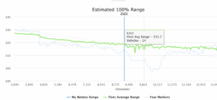The self discharge from a lithium battery is very low. This means that when the battery disconnect itself by the contactors (as it also does during a sleep) the drain of the battery is very slow.
Tesla warns about the low voltage battery can be damaged, because it will discharge quite quickly when not charged. Lead acid batteries wear bad from discharging too much and I think some 50% SOC is the safe level for these.
So the lithium battery in a Tesla that shut down is safe for some further time(quite long time). I would not recommend trying to find the time though.
For calendar aging, lithium batteries is better of the lower the SOC is down to zero %. Note, that this is discharged to the safe level, 0% SOC but still within the minimum voltage level. From this they are
left in that state for about a month or two in the research tests, then a few cycles and discharge is performed to find the capacity and after that they are charged or discharged to the SOC they use in the test.
In this test the battery cells is left as the test SOC( 0% for the 0% points) for two to three months without getting damaged, they actually have the least degradation despite 2-3 months a time at 0% SOC, and 10 months in total.
View attachment 799982
This picture show the calendar aging for NCA, NMC and LFP cells. While it is a recent test, and other tests show the same, we actually do not have data on the absolute newest battery cells. But as the basic chemistry do not change very much for each type we can use these results as a base for understanding the degradation frm time on these battery types. In some cases the newest cells might have slightly reduced (or increased) cyclic aging or calendar aging.
For LFP there is a need to charge full to reset the BMS energy counter on a regular basis. LFP has very flat voltage curve and the BMS counter of the actual remaining stored energy might drift and in the worst case you find yourself stranded when the battery goes empty despite the BMS did think there still was plenty left.
LFP suffer from calendar aging but as you can see the calendar aging is not that bad at 100% for specially shorter periods.
We can expect LFP cars to have slighty less degradation for the same use, just to give a number about half compared to LR and P cars. This because calendar aging is the dominant degradation factor for both types.
This is actually also possible to see in teslalogger.de/degradation. The LFP versions seem to loose about half the range per driven miles/km. In reality the calendar aging comes per time and not km/mile but there is no such graphs.
Its also a bit early to say for sure as LFP has not been around in Teslas for that long, but the facts we have from research points in that direction.




